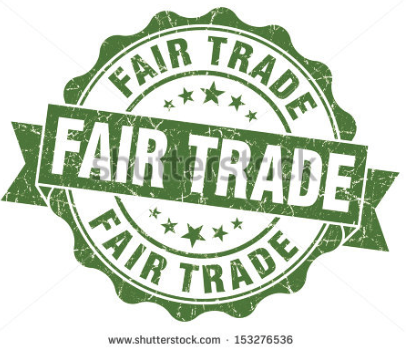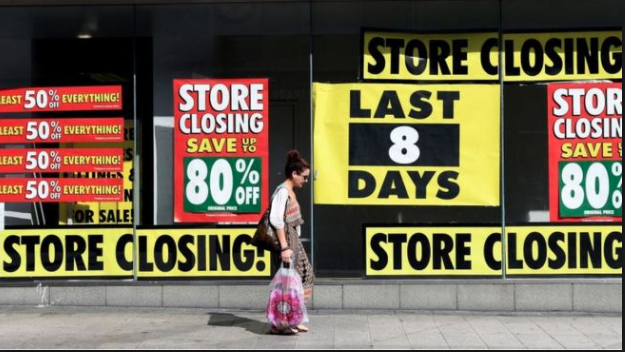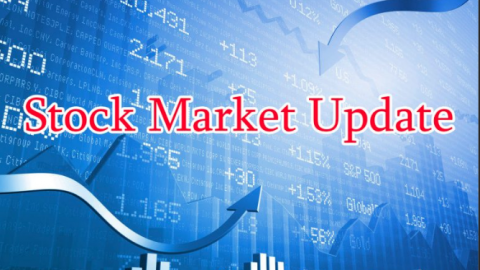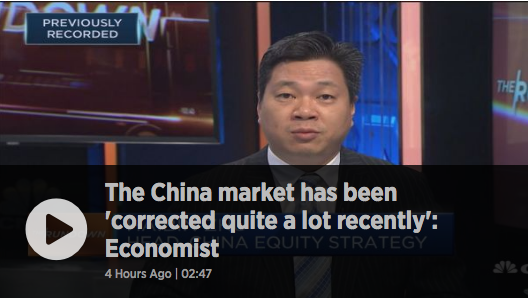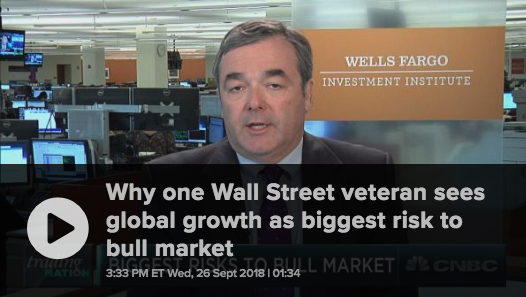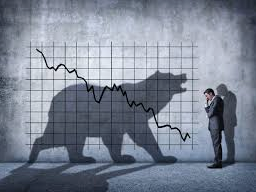This is the kind of equity market atmosphere or climate can often find investors on the outs, giving up on equities and lacking for long-term vision. For more than a month, the major averages have found themselves correcting by over 10% only to rally by 6% and now with the Dow and S&P 500 back down and near recent lows. It’s been some time since real fear has gripped the Dow and S&P 500, but here we are and with fear a plenty. Much of that fear has heightened around the possibility of trade wars.
Yesterday it was announced by the White House and President Donald Trump that anti-China trade tariffs would be implemented. Trump said the taxes were intended to penalize Beijing for allegedly stealing Washington’s intellectual property. The Dow Jones industrial average dropped 724.42 points to close at 23,957.89 with trade war fears spreading throughout Asian markets overnight. With one session left to go, the Dow and S&P 500 are each down nearly 4% for the week and the Nasdaq is facing a loss of over 4% for the week. That would mark the worst week for the indexes since the week ending Feb. 9, 2018.
President Trump’s declaration in favor of trade tariffs pointed at China has already triggered a swift response from Beijing. Chinese authorities said they could hit 128 U.S. products with tariffs in response to Trump’s memorandum proposing charges on up to $60 billion worth of Chinese products. The Chinese move includes an initial 15% levied on fruit, nuts, wine and stainless steel pipes. A second round of 25% tariffs would be aimed at pork and recycled aluminum would be imposed after China further evaluated U.S. penalties. Chinese Ambassador to the U.S. Cui Tiankai said on state television that the country would “fight to the end,” with regards to a trade war.
Moreover, it is not just China that is opposed to the implementation of such trade tariffs. U.S. industry experts are opposed to the tariffs as they might spill over and into other industries.
“The tariff idea is a war that you just can’t win,” Rick Helfenbein, the president and CEO of the American Apparel & Footwear Association, told CNBC Friday.
We don’t like it, we’re very concerned as an industry that apparel and footwear and accessories might be on the list, and if they are on the list it really would not be good for our industry.”
Other industry experts within agriculture fear that China would retaliate against the U.S. soybean growers. China imports $14.2 billion worth of soybeans annually and any retaliatory China tariffs on the product would have an impact on U.S. producers, John Heisdorffer, president of the American Soybean Association, told CNBC Friday.
“China’s our number one customer,” said Heisdorffer. “One out of every three rows of soybeans that we grow here in the U.S. goes to China, so it’s a big impact.”
The bottom line is a trade war is a war by any other name and in the case of a war, rarely anybody comes out for the better. That is the message U.S. industry leaders are presently trying to convey to the White House. You would be hard-pressed to find anybody who is of the opinion that these targeted tariffs offered by the White House are favorable or will have a positive outcome.
A recent survey was conducted by The CNBC Global CFO Council, which represents some of the largest public and private companies in the world, collectively managing more than $4.5 trillion in market capitalization. The survey was conducted after President Donald Trump signed a pair of proclamations that impose tariffs on imported steel and aluminum, but before the announcement of tariffs aimed at China. The results from the survey are noted below:
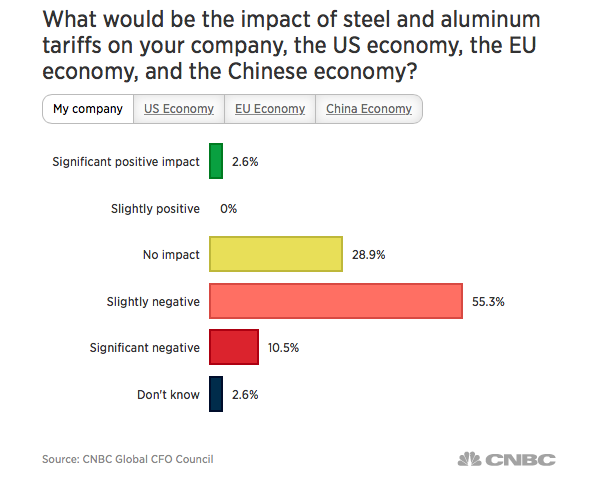
If there is a silver lining to be found in the latest headlines concerning U.S. imposed tariffs it comes from a late Thursday announcement on previously announced tariffs. The White House late Thursday approved tariff reprieves for the European Union plus six other nations, including Canada and Mexico. The move basically eliminates the formerly proposed tariffs on steel and aluminum and invites all nations to work together in order to reduce overcapacity.
In other news, that has been pushed to the sidelines given the concerning environment for equity markets around the globe, the U.S. government averted another shutdown as the Senate passed a $1.3 spending bill, which will now go to the desk of President Trump for his signature. President Donald Trump’s national security adviser Lt. Gen. H.R. McMaster will resign and be replaced by John Bolton, the New York Times first reported late Thursday.
Also occurring today will be more Fed speeches. Minneapolis Fed President Neel Kashkari will take part in a discussion about the economy in New York at 10:30 a.m. Eastern, Dallas Fed President Rob Kaplan will appear at the Trellis Foundation Summit at 11:30 a.m. Eastern and Boston Fed President Eric Rosengren will give a speech at the Fed’s international research forum at 7 p.m. Eastern.
The risk-off trade is in affect as the major averages fight through this correction period and in search of stability. What we know lay beneath these trade fears is a strong global economy. U.S. corporations are expected to grow earnings in the mid-teens through 2018 with the S&P 500, Q1 2018 earnings expected to grow some 18 percent. Right now, however, many investors fail to see the forest through the trees as they say. But it’s important to recognize one critical fact: NO TRADE TARIFFS HAVE BEEN IMPLEMENTED, JUST PROCLAIMED!
There is a window of opportunity, as there were with the steel and aluminum proposed tariffs, for nations to negotiate and come together for the common good of global economic fairness and prosperity. Finom Group’s President and Chief Market Strategist, Seth Golden, is of the opinion that the rhetoric and proclamations surrounding tariffs is a negotiating strategy that aims to curb excess capacity in certain industries and introduce more stringent enforcement for the protections of intellectual property.
“As it was with the steel and aluminum proposed tariffs, many “carve outs and/or exclusions” were achieved, giving little efficacy to the proposed tariffs and therefore minimal adverse affects from such tariffs. That is the more likely outcome from the announced, China-targeted trade tariffs from the White House. We’re going into mid-term elections and the White House, which has been in a constant state of turmoil can’t afford to lose its base and at the heart of that base are the nation’s farmers and agriculture industry workers. China, if pushed too hard, would retaliate directly at this U.S. industry. It would raise costs for everyone and that is the biggest leverage China has. I doubt even they would want to go that route and the President’s advisors are likely aware of this. The risk is too great to the White House and Republicans, should China retaliate against our agriculture industry.”
While cooler heads may prevail through a negotiated settlement on trade, the damage has been done and may still remain to be seen in the coming weeks…to equity markets around the globe. In the new market world of algorithms and electronic, programmed trading, when the technicals breakdown, they tend to not respond to fundamentals i.e. corporate earnings. As such, we’ll have to see if the S&P 500 double bottoms near term, which is still another 110 points or so lower from yesterday’s close of 2,643. The trees are all around the markets presently, but we would encourage investors and traders alike to see the forest beyond the trees. The wall of worry looms larger for investors than in previous years during the bull market cycle, but with time, markets follow earnings…ALWAYS!
.
Tags: SPY DJIA IWM QQQ
